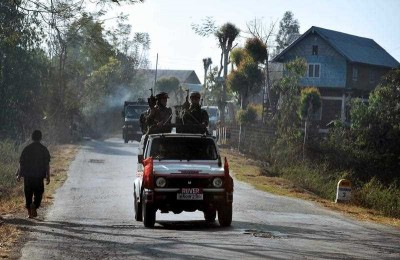
India’s political leadership failed to capitalise on the opportunity to effectively put across a larger message due to the chest-thumping that followed the Myanmar ops. This misstep ended up straining two important bilateral relationships.
On 4 June, the Indian Army suffered its worst casualties in almost a decade when 18 soldiers were killed and 14 injured in an attack by insurgents belonging to the National Socialist Council of Nagaland’s Khaplang faction (NSCN-K) in Chandel district, Manipur. The Indian government was quick to respond by launching a special forces operation in the early hours of 9 June. Operation Peace led to attacks on insurgent camps belonging to the NSCN-K.
While operations across or along the Indo–Myanmar border are nothing new for the Indian military, the government made two significant departures from the norm. The swift Indian response came less than a week after the ambush of the Indian soldiers in Manipur and was approved at the highest levels of the Indian government.
The government also broke its cardinal rule of ‘silence’ following special-forces operations. While the initial Indian Army statement cloaked the operation in ambiguity and reported that it was carried out along the border, Minister of State for Information and Broadcasting Rajyavardhan Singh Rathore told media that the ‘surgical strikes had been carried out a few kilometres inside Myanmar’.
Zaw Htay, the director of the office of Myanmar President Thein Sein, alsoacknowledged the fact that the operation was carried out inside Myanmar. This is not surprising given that both countries have been jointly carrying out coordinated operations since 1986. In 2010, India and Myanmar signed an agreement allowing Indian forces to pursue insurgents across the border. This was followed by a memorandum of understanding signed in May 2014 that provided for coordinated patrolling and intelligence sharing.
India’s decision to own up to the operations was a political one. Rathore’s statement was a calculated strategy to signal India’s intent. The statement that ‘India would carry out surgical strikes at the time and place of our choosing against any future attacks against Indians’ was directed at Pakistan without specifically naming the country. This was followed up with another statement by Union Minister Prakash Javadekar that the operation ‘speaks volumes about India’s resolve to fight terror. This is a lesson and a message to all the terror groups that India will not hesitate in going beyond its geographical borders to eliminate terrorists’.
But having let the proverbial cat out of the bag, the Indian government failed to shape the media narrative. Following these statements, the successful military operation caused a frenzy on news channels and social media. The race for viewership resulted in the casualty figures being inflated from 15–20 to about 100 and circulation of fake pictures of the army personnel allegedly involved in the cross-border raids.
The media hype has come at a cost. Owning up to Indian involvement blew the cover of plausible deniability, went against standard operating procedures and ultimately put Naypyidaw on the back foot. Going back on the earlier statement, Myanmar then denied that Indian forces had entered its territory. During Indian National Security Advisor Ajit Doval’s visit to Myanmar on 17 June, Naypyidawturned down India’s proposal for joint operations against NSCN-K cadres.
The Indian government’s failure to ensure a flow of reliable information and poor media management put avoidable pressure on an ally, damaged a bilateral relationship carefully cultivated over decades and squandered a moment of success.
Given the possibility of successful negotiations between the Indian government and the NSCN faction led by Isak Swu and T. Muivah (NSCN-IM), the Indian military’s offensive against the Khaplang faction has stoked fears of revenge attacks by the group in cooperation with other insurgent groups. The prevailing situation and the Indian military offensive could result in increased attacks against Indian security forces in the future.
The entire episode has raised hackles in Pakistan with statements from Prime Minister Nawaz Sharif and other political and military leaders. Pakistani generals warned India against carrying out any similar ‘misadventure’ in Pakistan. If the Indian government were to launch a surgical strike into Pakistan in the future, the Indian military will come up against an adversary on the guard. India’s leaders have unwittingly made an already difficult task much more arduous.
Following the Indian ministers’ statements, the media went overboard with unwarranted comparisons between the successful operation in Myanmar and future operations in Pakistan. Such comparisons are akin to comparing chalk and cheese.
In Myanmar, Indian forces were working alongside a cooperative ally and targeting Indian insurgent groups. A special-forces operation against Pakistan-based anti-India terrorist groups would face stronger defences and a Pakistani military determined to thwart Indian efforts. India will also have to ponder how to contain the possible escalation of the operations into a potentially wider conflict.
If India’s intent was to signal New Delhi’s resolve in tackling any future anti-India attacks, the Indian Army’s initial statement would have been good enough. After taking a risky political decision to launch the special-forces operation into Myanmar, the Indian government took another calculated risk in publicly signalling its resolve in responding proactively to any future attacks on Indian interests. But it did little to actively handle the flow of reliable information, allowing the media to run riot.
While the military succeeded in achieving its objectives, India’s political leadership failed to capitalise on the opportunity to effectively put across a larger message. This misstep whittled down a well-deserved military success and ended up straining two important bilateral relationships.
This article has been republished from Eastasiaforum.org.